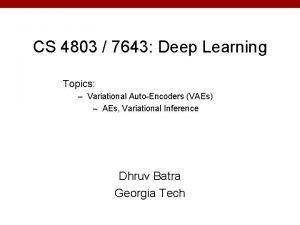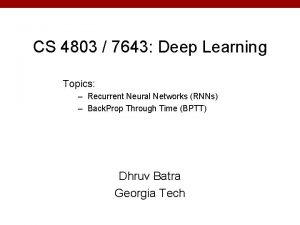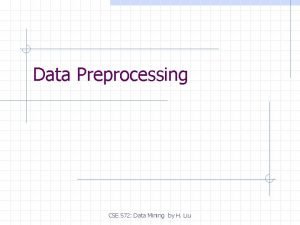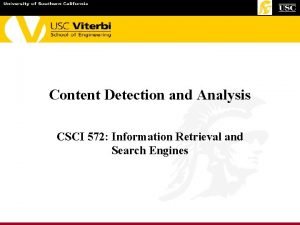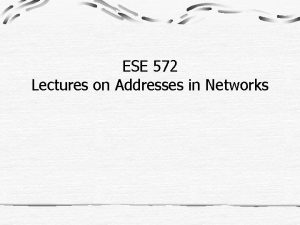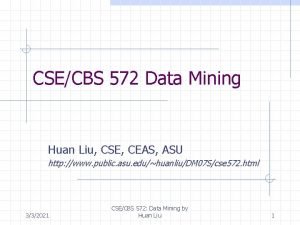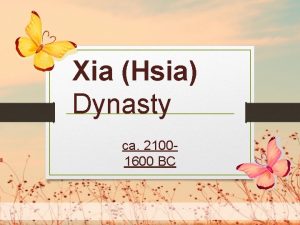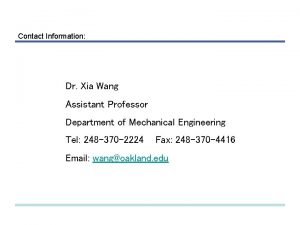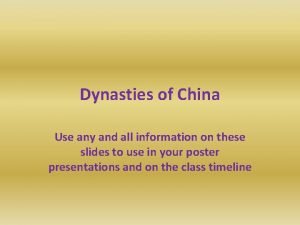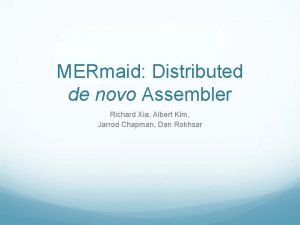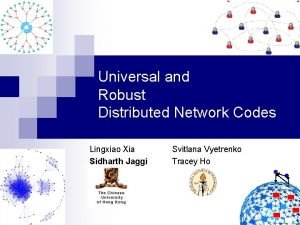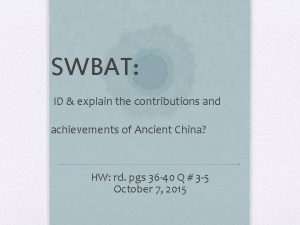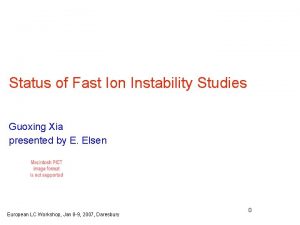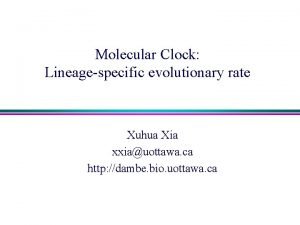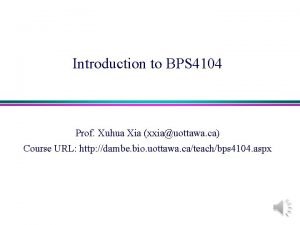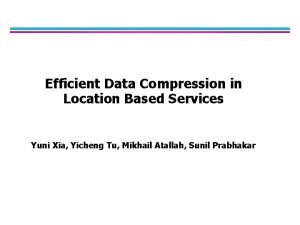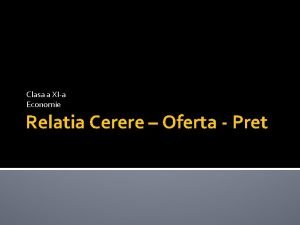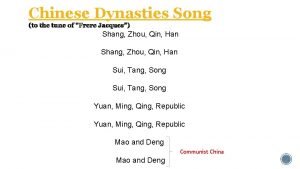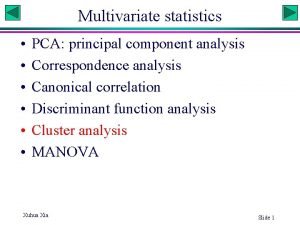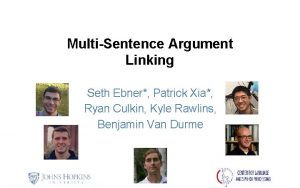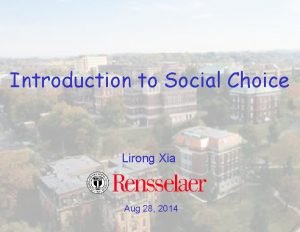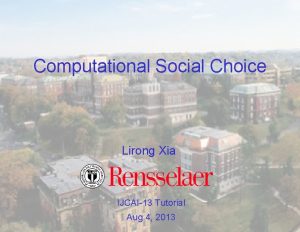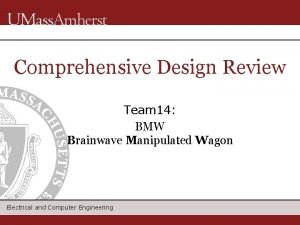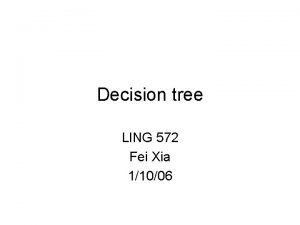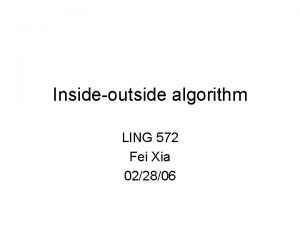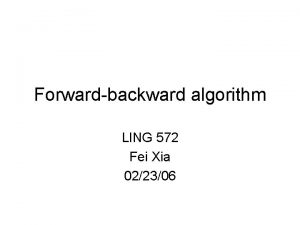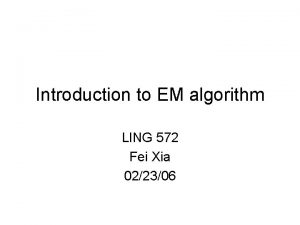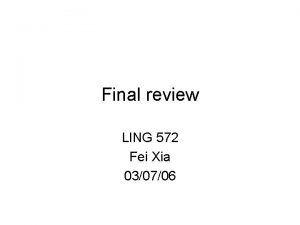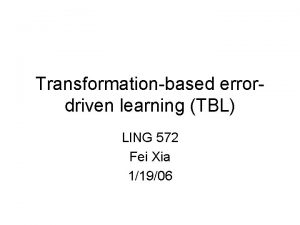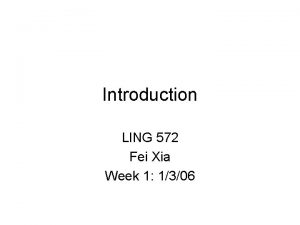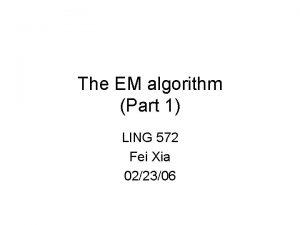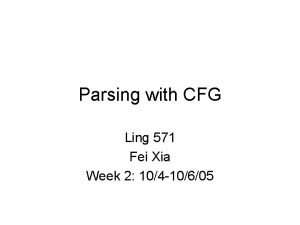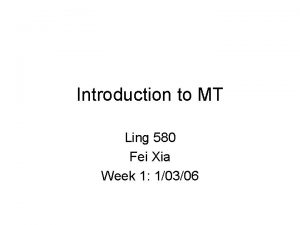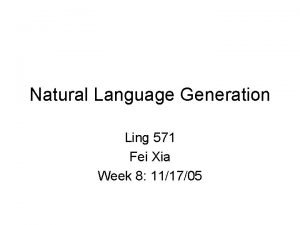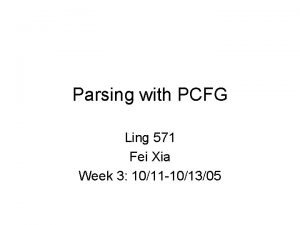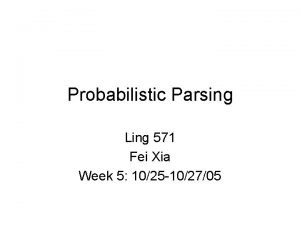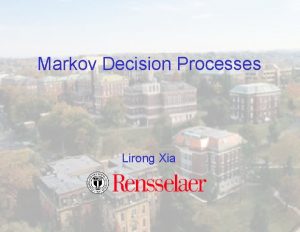Decision List LING 572 Fei Xia 11206 Outline





















![The general greedy algorithm • Rule. List=[], E=training_data • Repeat until E is empty The general greedy algorithm • Rule. List=[], E=training_data • Repeat until E is empty](https://slidetodoc.com/presentation_image_h2/7fe67d1d05114d13a34f7a5341398deb/image-22.jpg)






















- Slides: 44

Decision List LING 572 Fei Xia 1/12/06

Outline • Basic concepts and properties • Case study

Definitions • A decision list (DL) is an ordered list of conjunctive rules. – Rules can overlap, so the order is important. • A k-DL: the length of every rule is at most k. • A decision tree determines an example’s class by using the first matched rule.

An example A simple DL: 1. If X 1=v 11 && X 2=v 21 then c 1 2. If X 2=v 21 && X 3=v 34 then c 2 Classify an example=(v 11, v 21, v 34) The DL is 2 -DL.

Rivest’s paper • It assumes that all attributes (including goal attribute) are binary. • It shows DL is easily learnable from examples.

Assignment and formula • Input attributes: x 1, …, xn • An assignment gives each input attribute a value (1 or 0): e. g. , 10001 • A boolean formula (function) maps each assignment to a value (1 or 0):

• Two formulae are equivalent if they give the same value for same input. • Total number of different formulae: Classification problem: learn a formula given a partial table

CNF an DNF • Literal: • Term: conjunction (“and”) of literals • Clause: disjunction (“or”) of literals • CNF (conjunctive normal form): the conjunction of clauses. • DNF (disjunctive normal form): the disjunction of terms. • k-CNF and k-DNF

A slightly different definition of DT • A decision tree (DT) is a binary tree where each internal node is labeled with a variable, and each leaf is labeled with 0 or 1. • k-DT: the depth of a DT is at most k. • A DT defines a boolean formula: look at the paths whose leaf node is 1. • An example

Decision list • A decision list is a list of pairs (f 1, v 1), …, (fr, vr), fi are terms, and fr=true. • A decision list defines a boolean function: given an assignment x, DL(x)=vj, where j is the least index s. t. fj(x)=1.

Relations among different representations • CNF, DT, DL • k-CNF, k-DT, k-DL – For any k < n, k-DL is a proper superset of the other three. – Compared to DT, DL has a simple structure, but the complexity of the decisions allowed at each node is greater.

k-CNF and k-DNF are proper subsets of k-DL • k-DNF is a subset of k-DL: – Each term t of a DNF is converted into a decision rule (t, 1). • k-CNF is a subset of k-DL: – Every k-CNF is a complement of a k-DNF: k-CNF and k-DNF are duals of each other. – The complement of a k-DL is also a k-DL. • Neither k-CNF nor k-DNF is a subset of the other – Ex: 1 -DNF:

K-DT is a proper set of k-DL • K-DT is a subset of k-DNF – Each leaf labeled with “ 1” maps to a term in k-DNF. • K-DT is a subset of k-CNF – Each leaf labeled with “ 0” maps to a clause in k-CNF k-DT is a subset of

K-DT, k-CNF, k-DNF and k-DT k-CNF k-DT K-DL k-DNF

Learnability • Positive examples vs. negative examples of the concept being learned. – In some domains, positive examples are easier to collect. • A sample is a set of examples. • A boolean function is consistent with a sample if it does not contradict any example in the sample.

Two properties of a learning algorithm • A learning algorithm is economical if it requires few examples to identify the correct concept. • A learning algorithm is efficient if it requires little computational effort to identify the correct concept. We prefer algorithms that are both economical and efficient.

Hypothesis space • Hypothesis space F: a set of concepts that are being considered. • Hopefully, the concept being learned should be in the hypothesis space of a learning algorithm. • The goal of a learning algorithm is to select the right concept from F given the training data.

• Discrepancy between two functions f and g: • Ideally, we want to be as small as possible. • To deal with ‘bad luck’ in drawing example according to Pn, we define a confidence parameter:

“Polynomially learnable” • A set of Boolean functions is polynomially learnable if there exists an algorithm A and a polynomial function when given a sample of f of size drawn according to Pn, A will with probability at least output a s. t. Furthermore, A’s running time is polynomially bounded in n and m. • K-DL is polynomially learnable.

How to build a decision list • Decision tree Decision list • Greedy, iterative algorithm that builds DLs directly.

The algorithm in (Rivest, 1987) 1. If the example set S is empty, halt. 2. Examine each term of length k until a term t is found s. t. all examples in S which make t true are of the same type v. 3. Add (t, v) to decision list and remove those examples from S. 4. Repeat 1 -3.
![The general greedy algorithm Rule List Etrainingdata Repeat until E is empty The general greedy algorithm • Rule. List=[], E=training_data • Repeat until E is empty](https://slidetodoc.com/presentation_image_h2/7fe67d1d05114d13a34f7a5341398deb/image-22.jpg)
The general greedy algorithm • Rule. List=[], E=training_data • Repeat until E is empty or gain is small – f = Find_best_feature(E) – Let E’ be the examples covered by f – Let c be the most common class in E’ – Add (f, c) to Rule. List – E=E – E’

Problem of greedy algorithm • The interpretation of rules depends on preceding rules. • Each iteration reduces the number of training examples. • Poor rule choices at the beginning of the list can significantly reduce the accuracy of DL learned. Several papers on alternative algorithms

Summary of (Rivest, 1987) • Formal definition of DL • Show the relation between k-DL, k-CNF, k. DNF and k-DL. • Prove that k-DL is polynomially learnable. • Give a simple greedy algorithm to build k. DL.

Outline • Basic concepts and properties • Case study

In practice • Input attributes and the goal are not necessarily binary. – Ex: the previous word • A term a feature (it is not necessarily a conjunction of literals) – Ex: the word appears in a k-word window • Only some feature types are considered, instead of all possible features: – Ex: previous word and next word • Greedy algorithm: quality measure – Ex: a feature with minimum entropy

Case study: accent restoration • Task: to restore accents in Spanish and French A special case of WSD • Ex: ambiguous de-accented forms: – cesse, cessé – cote côté, côte, coté • Algorithm: build a DL for each ambiguous de-accented form: e. g. , one for cesse, another one for cote • Attributes: words within a window

The algorithm • Training: – Find the list of de-accent forms that are ambiguous. – For each ambiguous form, build a decision list. • Testing: check each word in a sentence – if it is ambiguous, then restore the accent form according to the DL

Step 1: Identify forms that are ambiguous

Step 2: Collecting training context Context: the previous three and next three words. Strip the accents from the data. Why?

Step 3: Measure collocational distributions Feature types are pre-defined.

Collocations

Step 4: Rank decision rules by loglikelihood There are many alternatives. word class

Step 5: Pruning DLs • Pruning: – Cross-validation – Remove redundant rules: “WEEKDAY” rule precedes “domingo” rule.

Building DL • For a de-accented form w, find all possible accented forms • Collect training contexts: – collect k words on each side of w – strip the accents from the data • Measure collocational distributions: – use pre-defined attribute combination: – Ex: “-1 w”, “+1 w, +2 w” • Rank decision rules by log-likelihood • Optional pruning and interpolation

Experiments Prior (baseline): choose the most common form.

Global probabilities vs. Residual probabilities • Two ways to calculate the log-likelihood: – Global probabilities: using the full data set – Residual probabilities: using the residual training data • More relevant, but less data and more expensive to compute. • Interpolation: use both • In practice, global probability works better.

Combining vs. Not combining evidence • Each decision is based on a single piece of evidence. – Run-time efficiency and easy modeling – It works well, at least for this task, but why? • Combining all available evidence rarely produces different results • “The gross exaggeration of prob from combining all of these non-independent log-likelihood is avoided”:

Summary of case study • It allows a wider context (compared to ngram methods) • It allows the use of multiple, highly nonindependent evidence types (compared to Bayesian methods) kitchen-sink approach of the best kind

Advance topics

Probabilistic DL • DL: a rule is (f, v) • Probabilistic DL: a rule is (f, v 1/p 1 v 2/p 2 … vn/pn)

Entropy of a feature q T: fired S: S S 1 2 … Sn q not fired T-S:

Algorithms for building DL • • • AQ algorithm (Michalski, 1969) CN 2 algorithm (Clark and Niblett, 1989) Segal and Etzioni (1994) Goodman (2002) …

Summary of decision list • Rules are easily understood by humans (but remember the order factor) • DL tends to be relatively small, and fast and easy to apply in practice. • DL is related to DT, CNF, DNF, and TBL. • Learning: greedy algorithm and other improved algorithms • Extension: probabilistic DL – Ex: if A & B then (c 1, 0. 8) (c 2, 0. 2)
 Fei fei li
Fei fei li Cs 4803
Cs 4803 Objectives of decision making
Objectives of decision making Investment decision financing decision dividend decision
Investment decision financing decision dividend decision Jelaskan chord apa yang disusun oleh nada 572
Jelaskan chord apa yang disusun oleh nada 572 Cse 572
Cse 572 Csci 572
Csci 572 Ese 572
Ese 572 Data mining
Data mining Find the odd one : 396, 462, 572, 427, 671, 264
Find the odd one : 396, 462, 572, 427, 671, 264 Hsia dynasty
Hsia dynasty Guoxing xia
Guoxing xia Jennifer xia
Jennifer xia Dr xia wang
Dr xia wang It indicates ambition, cool-headedness, and fierceness.
It indicates ambition, cool-headedness, and fierceness. Ito ang unang banyagang dinastiya ng china
Ito ang unang banyagang dinastiya ng china Longest chinese dynasty
Longest chinese dynasty Albert xia
Albert xia Tian shang tian xia wei wo du zun
Tian shang tian xia wei wo du zun Lingxiao xia
Lingxiao xia Xia dynasty achievements
Xia dynasty achievements Guoxing xia
Guoxing xia Xia red
Xia red Molecular clock hypothesis
Molecular clock hypothesis Laura iordache
Laura iordache Xuhua xia
Xuhua xia Qfrost
Qfrost Xia red
Xia red Yuni xia
Yuni xia Guoxing xia
Guoxing xia Cerere oferta pret
Cerere oferta pret Han sui tang song
Han sui tang song Amy xia amgen
Amy xia amgen Xuhua xia
Xuhua xia Perfume xia xiang
Perfume xia xiang Kñp
Kñp Seth ebner
Seth ebner Lirong xia
Lirong xia Lirong xia rpi
Lirong xia rpi Qiangfei xia
Qiangfei xia Monsoons
Monsoons Fei dressage tests
Fei dressage tests Explosion w fei
Explosion w fei Shutterstock
Shutterstock (fei-sp) leia atentamente
(fei-sp) leia atentamente
